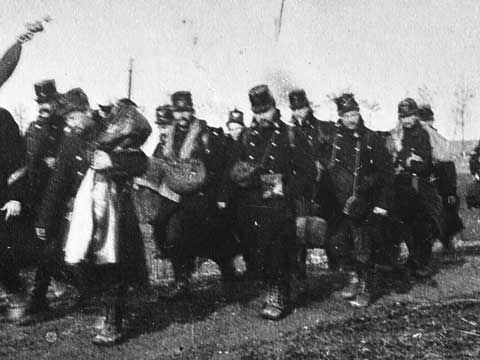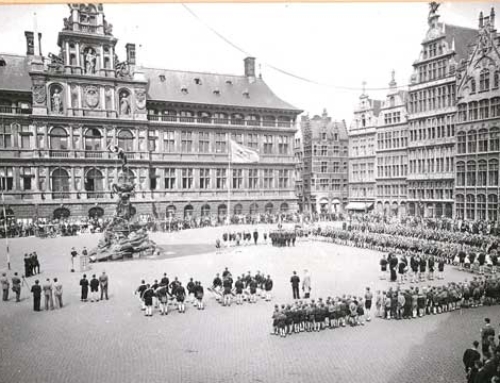Image: Militairespectator.nl – Belgian army in World War 1
Should you have missed parts 1 and/or 2 and/or 3, here where’s to read them first:
The diamond sector under the sequester
The post-war sequester legislation served to economically dismantle the enemy on Belgian territory. In view of the later sale, in principle all properties of enemies had to be placed under sequester. Only when the owner could prove that he was no longer a subject of the enemy nation could he dispose of his goods freely. In practice this sometimes took a very long time, too long, as a result of which the disaster was often already done and personal items were already sold before the proof of nationality could be presented.
For 222 persons from the Antwerp diamond world a personal sequester was appointed in the course of 1919, in total spread over 202 sequester files. In 65% of the cases these were Austrians, 21% Ottomans, 10% Germans and 4% Hungarians. After the war, after the peace negotiations and after the redrawing of the European map, the majority of them changed their nationality. Some also deliberately chose to adopt another nationality, or had themselves declared homelandless, so that the sequester would be lifted. Thus, when the files are closed, we get a very different situation. Now 53% of the diamond workers under sequestration appear to have Polish nationality, 12% are Israelites from the Levant, 7% Austrian, 4% German, Czechoslovak or Turk, 3% patriotic or Armenian, 2% Russian, Belgian or American, 1% is Hungarian, Dutch or Syrian and finally 0,5% British, Ukrainian, Palestinian, Romanian or Swiss. Diamond dealers, manufacturers and brokers are strikingly common (accounting for 87% of the files) and few diamond processors (13%).
Perhaps the Prosecutor General’s Office of Antwerp preferred to place people suspected of being rich under the prosecutor’s office rather than people suspected of being the opposite. The economic profile of the diamond workers differed greatly. At one extreme there are examples of traders with household effects worth no more than 200 Belgian francs (converted to today this corresponds to €1,040). At the other extreme, there were the most successful manufacturers and traders like these who lived in the residential district of Zurenborg, Antwerp.
In order to keep or not to keep the person’s property in coercive control, the Prosecutor’s Office relied mainly on nationality, but in some cases religion was also a decisive element. For example, the files show that Christians (Armenians) and Jews (Israelites from the Levant) from the former Ottoman Empire were exonerated, but Islamists (Turks) were permanently considered enemies and thus their property remained under sequestration.
The period during which a person’s property was under sequester varied greatly. Some were able to dispose of their property again after only a few days upon presentation of a valid nationality certificate, for the less fortunate, mainly those who were permanently considered enemies, the file was closed only after the sale of all property had been completed.
Of all the nationalities that were henceforth considered ex-enemies, the files of Israelites from the Levant were closed again the fastest on average (after an average of 11 months). The fact that this group was the most affluent and had already lived in Antwerp for a long time will not have been unusual.
Poles were also able to dispose of their goods fairly quickly on average (13 months), so it was usually not so difficult for them to prove their new nationality. The same was true for Armenians and Czechoslovakians (20 and 21 months respectively).
Note that quite quickly still must have been a long period to bridge, from a few months to more than a year not being able to handle personal matters and having to find an alternative source of income is certainly not nothing.
Demonstrating that you were without homeland was a lot harder. The process, which involved court cases and police investigations, took an average of three years.
The bilateral agreement between Belgium and Austria of August 9, 1922, regulated the sale of Austrian goods under the sequester and also the release of Hungarian property. This is reflected in the sequester files, on average 3 years and 9 months after opening the sequester file, the files of Hungarians were closed again.
With the Treaty of Lausanne with Turkey of 1923, all former Ottomans are now exempted from sequestration. Nevertheless, practice shows that for many of them the sequestration procedure took much longer. Often the goods were sold anyway and it no longer mattered to the person in question whether his file was closed or not.
The law of November 17, 1921 prescribed the forced sale of all German property under sequester and on August 9, 1922 for Austrian property. Thus, since then, the closing of an Austrian or a German file meant as much as that the liquidation of the person or family in question was complete.
The last file relating to the diamond sector to be closed was that of the Diamond Club itself, in the significant year 1942.
What did the liquidation of the properties of enemy and ex-enemy diamond merchants bring to the Belgian treasury?
Data on forced sales are quite complete, which allows us to calculate the approximate total proceeds. The traced properties of Austrian and German diamond merchants were sold in their entirety. In total this was the case for 7 Germans and 7 Austrians, but much more was sold. As soon as one Allied or neutral creditor came forward, in principle the forced liquidation of the entire property of a hostile person could be ordered.
During the war, most foreign diamond merchants were abroad, so unpaid bills accumulated during the period of absence. When the person whose property was under sequester did not pay his outstanding bills in time or could prove his new nationality, all the property of the person in question was sold to pay the creditors.
In this way, a further 29 diamond merchants were economically “liquidated“. In total the liquidation of hostile diamond traders brought in about 2 million Belgian francs (more than 10 million euro today).
In relation to the size and importance of the Antwerp diamond sector, this revenue is ultimately not that much. The Belgian economy and the “national interest” would surely have benefited more by not shutting down the diamond merchants’ business for so long and by not “liquidating” them out of the country.
Moreover, among the 43 forced sales, there were only five commercial or industrial enterprises, including two polishing factories, twice an eighth of the shares of a polishing factory and finally shares of the Diamond Trade Exchange. All other cases involved private property, mainly furniture and further about three houses.
The sequestration legislation was therefore not only intended to provide money for the Belgian treasury and to finance the reconstruction of the country, but more than that it was a patriotic measure to purge the country of enemies and to compensate for the suffering of the war. However, this short-term thinking, motivated by strong emotions, could have meant the end of the Belgian diamond sector.
More than 80% percent of the diamond traders in Antwerp were foreigners, the lion’s share of whom were nationals of a hostile nation. If there would have been no restrictions for the nationals of the new nations, Antwerp/Belgium would have lost a very lucrative sector forever.
The damage to the Belgian diamond sector from the application of the post-war repressive measures was ultimately limited by the changed geopolitical situation and not by any favoritism to the sector.
If Poland, as well as Armenia, Syria, Czechoslovakia, etc., had not gained the independence after the war that caused them to change camps, these former enemy subjects would have been subjected to the same repressive measures as Germans and Austrians. Indeed, as far as the German colony of Antwerp was concerned, these “land cleansing” measures had not missed their effect, the German colony belonged to the past forever. The continued existence of the diamond industry would have been equally threatened if the subjects of the newly created countries had been permanently regarded as enemies. Amsterdam and London would have given the diamond industry a warm welcome.







